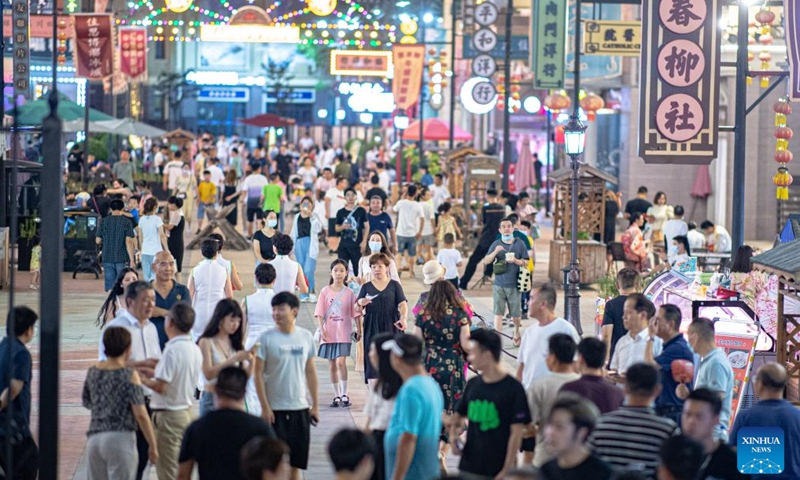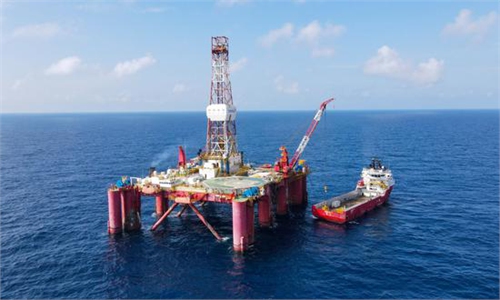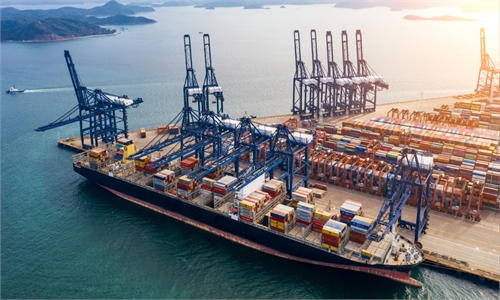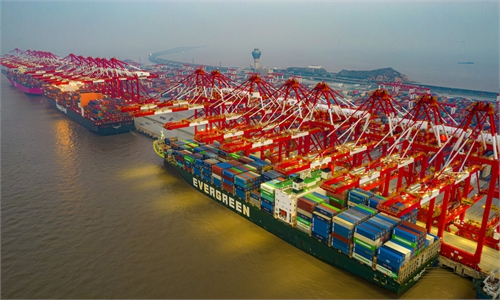
Photo taken on July 2, 2022 shows the view of a commercial street in Wuhan, central China's Hubei Province. In recent years, Hubei Province has striven to combine its night economy with culture and tourism in innovative ways, thus enhancing the vitality and attraction of nighttime consumption.(Photo: Xinhua)
China reported 86 domestically transmitted COVID-19 cases as some cities see sporadic resurgences, but analysts are optimistic that the country's overall economic recovery will not be affected as cities have gained experience in epidemic prevention.
The strong resilience of China's economy, complete industrial layout, fast-developing digital economy and large markets are sources of confidence for the country's economic recovery in the second half of 2022, despite Western media bad-mouthing.
Some cities in China have experienced COVID-19 flare-ups related to the Omicron subvariant BA.5 in recent days. Among the 86 domestic cases registered on Wednesday, 36 were in Northwest China's Gansu Province and 32 in South China's Guangdong Province. Jiangxi, Hainan, Jiangsu, Henan, Chongqing and Shanghai also reported cases.
Lanzhou in Gansu Province put four districts under a seven-day control procedure starting on Monday, asking people to stay inside their residential compounds.
The sporadic outbreaks raised questions on prospects for the country's economy, which just started to recover from the impact of outbreaks in megacities Shanghai and Beijing, as well as smaller cities.
"The latest sporadic resurgences across China may influence certain industry chains in some cities, but they won't affect China's overall economic recovery," Cao Heping, an economist at Peking University, told the Global Times.
Cao noted that the previous outbreaks in Shanghai and Beijing - two of China's most populated cities -- taught the country lessons about dealing with Omicron. Cities have improved screening, tracing and treatment of cases with more precise and targeted measures, said Cao.
In good news, Beijing had no high-risk areas as of Thursday and Anhui Province, which was battered by a sudden outbreak last week, reported zero cases on Thursday.
Western media seize every virus resurgence in China as a chance to criticize China's dynamic zero-COVID policy and keep bad-mouthing China's economy. Reuters reported on Thursday that China "has been tweaking its stringent COVID curbs but shows no sign of backing off," which leaves businesses "facing a prolonged period of uncertainty."
But according to Cao, who visited dozens of Chinese cities in coastal and inland areas since April, the dynamic zero-COVID policy helps create a better environment for an economic recovery and the resilience of the country's economy is stronger than many had predicted.
China will release second-quarter GDP growth data soon, and some foreign media predicted it to be just 1 percent. Cao predicted that GDP growth for the first half of the year may stand between 0.7 and 2.7 percent, and the economic recovery in the second half may speed up.
"In Kunshan, a city close to Shanghai that was affected by the outbreak in Shanghai, local officials and companies told me that export-oriented parts of the economy started to recover since June. The dynamic zero-COVID policy makes exports from China virus-free and clients are also assured about this ... overseas orders have been restored and increased," said Cao.
China's industrial layout is complete, meaning that an epidemic in one city or area may temporarily affect production but that can be compensated for through adjustment in other links of the manufacturing process, Cao said.
In response to pessimistic Western predictions, Cao said that in world history, countries with better resilience, complete industrial chains and a bigger economic scale usually had quicker recoveries after global strikes.
China's fast-developing digital economy, e-commerce platforms and large domestic market - all of these mean China's economy can survive and thrive, Cao said.
On Thursday, the National Development and Reform Commission (NDRC) held a press conference on the economic situation in the first half of 2022, and it said that China suffered economic fluctuations between March and mid-May due to the domestic epidemic resurgence, supply shocks, the Ukraine crisis and other unexpected factors. But with the effective COVID-19 prevention measures in key areas and the release of steady economic policies, the economy turned upward in June.
The Purchasing Managers' Index in June was 50.2, increasing 0.6 points from May.
Foreign trade has also grown fast since June, according to the NDRC, which predicted the economy in the second half of 2022 will maintain an upward trend with the highly effective COVID-19 control policy and macroeconomic policies.



